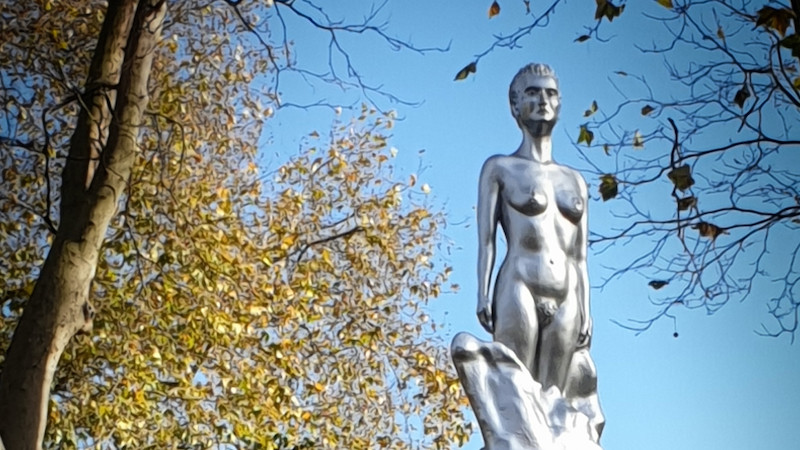A recently unveiled statue of Mary Wollstonecraft has caused outrage by depicting the pioneering feminist writer naked. The statue depicts a nude woman emerging from an amorphous mound of organic matter. The BBC described the statue as “a swirling mingle of female forms.”
The problem isn’t the statue. It’s the underlying unconscious shame that precludes our ability to engage with the naked body in a balanced, holistic, unobjectified way.
Who was Mary Wollstonecraft?
Wikipedia describes Wollstonecraft (1759-1797) as “an English writer, philosopher, and advocate of women’s rights.” She’s best known for A Vindication of the Rights of Woman (1792), which argued for women’s equal place in society. There are some serious writing genes here: Wollstonecraft was also the mother of Frankenstein author Mary Shelley.
Shortly after Wollstonecraft’s death, her second husband William Godwin published an unusually frank account of her life, Memoirs. It describes “her close friendship with a woman, her love affairs, her illegitimate child, her suicide attempts and her agonizing death” following childbirth complications.
Contemporary society rejected both Wollstonecraft’s ideas and lifestyle. Her reputation suffered until the rise of feminism a century later. Growing recognition led to a ten-year campaign to raise a statue of Mary opposite the Newington Green Unitarian Church in London that she attended. The statue by Maggi Hambling was unveiled on 10 November 2020.
Criticism of the statue
The unveiled statue drew immediate criticism.
Caroline Criado-Perez, who successfully campaigned for a statue of another feminist, Millicent Fawcett, felt the “representation is insulting to her [Mary Wollstonecraft]. I can’t see her feeling happy to be represented by this naked, perfectly formed wet dream of a woman.”
Criado-Perez has a point. The statue certainly fits within the boundaries of stereotypical representations of the female figure.
Guardian columnist Rhiannon Lucy Cosslett went straight for the genitals. In an article titled ‘Why I hate the Mary Wollstonecraft statue: would a man be ‘honoured’ with his schlong out?’ she railed that “none of us expected to find ourselves contemplating whether or not she had a full bush.”
“Challenging artwork”
Hambling responded that it was “a sculpture of an idea”—not of a particular woman at a particular point in history. “Statues in historic costume look like they belong to history because of their clothes. It’s crucial that she is ‘now’.”
Cosslett sees the nudity differently. She notes the difficulty of creating great public sculptures, particularly of women—who often end up nude. She calls it the “It’s a naked lady, so it must be art” syndrome.
“There’s a corporate blandness to these female figures… there’s a soullessness to much of it… [Is it] an attempt to please everyone and therefore ultimately and blandly, no one?”
Bee Rowlatt, one of the statue’s organisers, argues that Hambling’s work doesn’t sexualise the female figure. “It’s not inviting—it’s challenging. It’s a challenging artwork, and it’s meant to be.”
“Tits”
Writer Tracy King is forthright on the effect of the statue. “Any passing teenage boy is not going to think, oh, that’s an icon of feminist education. They are going to think—tits!”
She’s absolutely right. That’s because teenage boys are wired to respond to tits. This creates an opportunity that the Millicent Fawcett statue, in historical garb, doesn’t present. Engage the teens with the tits, then educate them.
“I do not wish women to have power over men but over themselves,” reads a quote from Mary Wollstonecraftat the base of the statue. In Mary, with her affairs, her passionate same-sex friendships, and her suicidal depression today’s teenagers may recognise—and relate to—a psychologically very modern figure.
Unconscious shame
There’s something else going on here: the use of schoolyard terms like tits, schlong and bush. Evolutionary psychologist Steven Pinker wrote that, “In all societies, sex is at least somewhat ‘dirty’.” We use jokey terms to ‘make light’ of things we find awkward or ‘dirty’.
Those uncomfortable feelings of awkwardness, of dirtiness, of a vague sense of doing something forbidden, are all symptoms of unconscious shame. When it comes to sexuality, it’s not just our teenagers who are adolescents. Collectively, we haven’t developed beyond our historical sexual shame to a healthy acceptance of human biology.
For me, the problem isn’t the Mary Wollstonecraft statue. It’s the underlying unconscious shame that precludes our ability to engage with the naked body—female or male, verbally or visually—in a balanced, holistic, unobjectified way.
This shame accounts for why there are so few statues of historical women, and why Mary Wollstonecraftendured so much hardship in her ferocious passion for female equality and for life itself. Personally, I believe Maggi Hambling’s statue does justice to its subject.
Oh—and when it comes time for my statue, can I please have one with my schlong out?
Photo by Grim23 on Wikimedia Commons (CC BY-SA 4.0)

